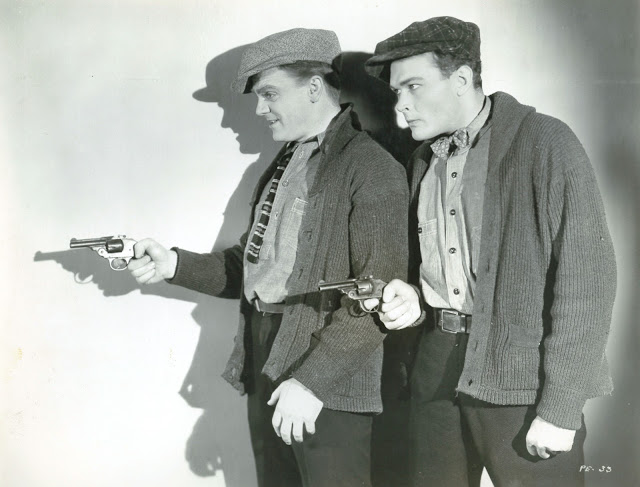The Watch List For 8/29/12
THE HANGMAN (1959) --- Bounty-motivated lawdog Robert Taylor in merciless quest of may-be innocent Jack Lord, as Tina Louise, in and out of clothes, seems to assist, mostly interferes. Fess Parker is ineffectual both at sheriffing and holding his own in scenes with Bob. Watch them and know why Fess never made a meaningful jump from TV to features. Here's a studio western when the species was getting tired. I kept expecting the Cartwrights to ride up on
HOEDOWN (1950) --- Country-swinging Eddy Arnold "stars," but it's more about timid cowboy Jock Mahoney who fakes his way into series western stardom with assist of Gene Autry's singing voice. Didn't enjoy this because Jocko is abused throughout by unappealing support players. Songs are good if limited. I may want an Eddy Arnold CD to rinse sour aftertaste of Hoedown. Jock's cowboy character personal-appears at a small-town theatre and nobody shows up. Did that ever happen to real-life B west stars? Too much cruelty in what's supposed to be a comedy. I kept wanting Mahoney's worm to turn and it only fitfully does. Another fine quality Columbia DVD, but I'd have left this one to nitrate's tender mercies.
PYGMY ISLAND (1950) --- Jungle Jim thwarts evildoing 'ginst white pygmy tribe led by Billy Curtis, who's as wilderness-bred as a Dead End Kid, likely as not to take out a cigar and light it. Jim's safari duds are drenched every time he dives after rubber gators, yet he's bone-dry moments later, as though
RETURN OF PETER GRIMM (1935) --- Slow and set-bound RKO wherein Lionel Barrymore comes back from beyond to correct family matters he bungled. Long and frustrating scenes where LB tries to communicate with the living, but can't. I got bored and sped up the final third. Things worked out and Barrymore stays dead. Nineteenth-century's David Belasco wrote the based-upon play, so even old Lionel might have called it antique. Among supernatural forays not played for chills. Maybe that was reason for the drag this was. Some nice moments though, and Edward (Thin Man) Ellis has probably his best role.
THIS SIDE OF HEAVEN (1934) --- Lionel Barrymore again with family troubles, these more engaging thanks to director William K. Howard swish-panning like he did in The Trial Of Vivienne Ware two years before. I enjoyed this better than Peter Grimm, being it's MGM with variety in settings and cast. Lionel is snookered by embezzling partner Edwin Maxwell, so obviously a crook and always type-cast as such that you wonder how they business-teamed in the first place. Mae Clarke and still-with-us Mary Carlisle (turned 100 this year!) are Barrymore daughters, Fay Bainter the wife. 30's casts are a comfort, even when the movie's nothing special. I'm beginning to notice how doggedly Lionel Barrymore played selfless fathers (but not always --- check out his harsh Dad in Sweepings). On TCM.
THE COCKEYED FAMILY (1928) --- Did it damage Ben Turpin's eyes to keep them crossed so much? That always bothered me, worrying that the poor man would go blind in service to his art. This was for the Weiss Brothers, budget practitioners of silent comedy during late-20's twilight. In this one, Ben's wife is "cockeyed" too, the effect less funny than frightful. There's chaos on a camping trip when baby Billy Barty brings home a skunk by the tail. I'd have refused scenes with polecats no matter assurance of de-odorizing same. The things always look ready enough to let go with spray, like Harold Lloyd's bomb that didn't turn out to be a harmless prop. You wonder how many silent comics got business ends of skunks not altogether fumigated. Turpin's eyes made his face seem inexpressive to me, like a store dummy thrown constantly in mud. Print quality on these Weiss shorts are amazing, all from camera negs and available on DVD from VCI. Fine audio commentary by Richard M. Roberts.
13 RUE MADELEINE (1947) --- Jim Cagney leads espionage agents into occupied
THE NICKEL-HOPPER (1926) --- Mabel Normand on the downgrade for Hal Roach. He was for getting what value was left in her celebrated name. Mabel had been luckless since a decade's beginning, from addiction issues to peripheral link with William Desmond Taylor's offing. A comedienne still much beloved, she looked sickly now, and Roach cameras, let alone dupey prints we're left with, were/are cruel. The Nickel-Hopper was a "special," another word for too long, but Mabel troupes nobly, plays a meltdown straight (drama she could flat do when needed). We don't wish much slapstick on her for condition she's clearly in. One of those comedies where you spend the whole time feeling sorry for the comedian. Care was taken on The Nickel-Hopper, Normand a major get for Roach. Babe Hardy beats a frenzied drum in club scenes, and glory be, it's Boris Karloff cadging a dance from Mabel. A pity she'd not live to see him triumph as the Frankenstein monster. Got this on DVD from Reel Classics on a disc with Raggedy Rose, also with Mabel Normand. Both have excellent scores by Ben Model.
























































